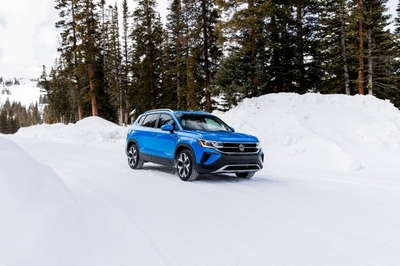Volkswagen Offers Winter Weather Driving Tips +VIDEO
Winter driving advice from Test and Development Driver Benjamin Leuchter and Peter Bunke, Head Trainer at the Volkswagen Driving Experience
HERNDON, VA: With the return of winter weather to many regions of the country, Volkswagen is offering advice on how to prepare for and drive in snowy conditions. We’ve turned to our German colleagues Benjamin Leuchter, Volkswagen Test and Development Driver, and Peter Bunke, Head Trainer at the Volkswagen Driving Experience, to share their top tips for cold weather driving.
“Many drivers either don’t know what to do when the weather gets cold or they are in a hurry and take shortcuts,” explains Benjamin Leuchter. “For example, they may only clear enough snow from the windshield to barely see out of instead of thoroughly removing snow from the vehicle. That puts both the driver and others on the road at risk.”
Before you hit the road
Leuchter suggests clearing snow and ice from all windows, not just the windshield. Also, remove any snow that is obscuring the side mirrors, headlights and license plates.
Remove snow from the roof of the vehicle, as this snow could hinder the drivers traveling behind you or fall forward, covering your windshield and blocking your own view.
Bunke recommends the use of high-quality winter tires in snowy conditions. Winter tires are designed to have better performance on snow than summer or all-season tires. It is important to note that tire pressures may drop with the temperature, so be sure to routinely check and set the tire pressures to the recommended levels for your vehicle.
Increase visibility by using washer fluids formulated to perform well at lower temperatures. You can also operate your vehicle’s heater and A/C at the same time to aid in the removal of moisture from the air inside the cabin. This helps reduce the amount of steam that could build up on the windshield and reduce visibility.
Be sure to check that your engine coolant and antifreeze mixture is at the recommended level and keep an eye on battery life. The car battery can be strained under a particularly heavy load in low temperatures and short trips may not allow enough time for the vehicle’s alternator system to recover the lost charge. A battery charger can help remedy lost battery starting power. If problems persist, a new battery may be a good investment. If unsure, consult your trusted car care professional.
Take it easy out there
It’s not best to start a vehicle and immediately drive at high speeds or at high rpms, especially in colder climates or after the vehicle has been parked for any
extended periods of time. Bunke’s tip is to drive at lower speeds and rpms for the first few miles until the engine has warmed.
Leuchter recommends refraining from using cruise control systems and increasing the distance between your vehicle and the car in front of you as stopping distances may increase in wintery conditions. He also suggests using caution and operating the vehicle with smooth and controlled actions and to avoid quick acceleration, aggressive steering and sudden braking. In Volkswagen vehicles equipped with drive mode selection, it’s best to use ECO mode because throttle response is muted, aiding traction. On VW vehicles equipped with DCC®, the comfort drive mode has softer throttle response and the power steering requires less force to steer.
Should you find yourself in a skid, Bunke suggests steering into the direction of the skid if the vehicle is oversteering and the rear wheels are sliding to the outside of the turn. He also suggests being very careful when accelerating if the vehicle is understeering and the front wheels slide to the outside of a turn. Many modern vehicles are equipped with technology to help with traction in slippery conditions: however driving at lower speeds and rpms may help to reduce wheel spin, sliding and the need for the assist systems to intervene.
When driving during winter weather conditions, ensure that your vehicle is equipped with appropriate all- season or winter tires. Always drive in a manner appropriate for the weather, visibility and road conditions.



